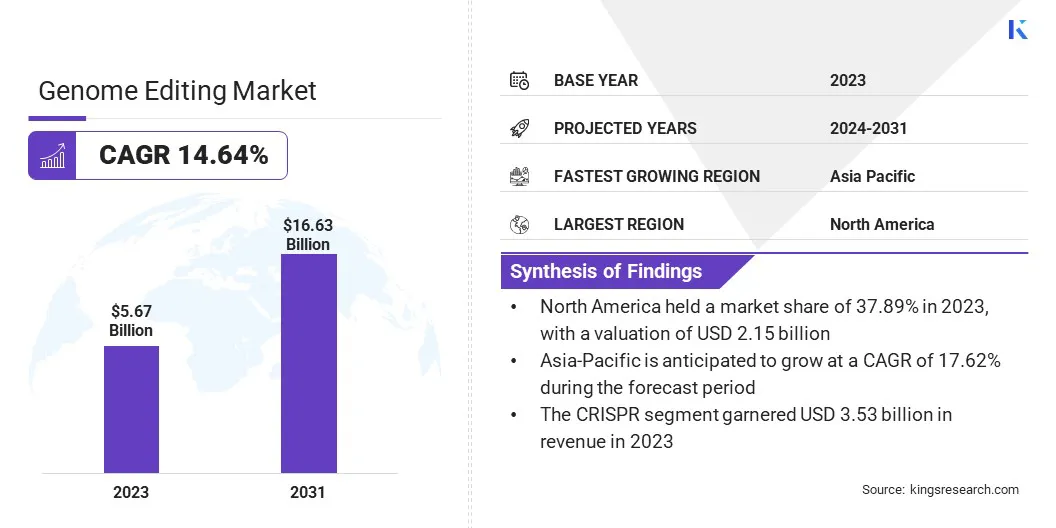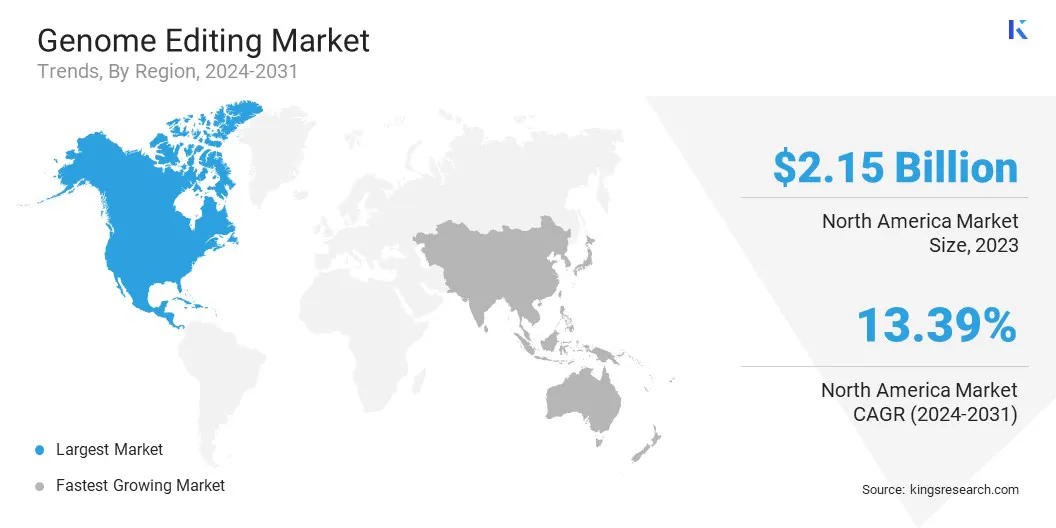Genome Editing Market Size
The global Genome Editing Market size was valued at USD 5.67 billion in 2023 and is projected to grow from USD 6.39 billion in 2024 to USD 16.63 billion by 2031, exhibiting a CAGR of 14.64% during the forecast period. The market is expanding rapidly due to rising applications in agriculture and biotechnology.
Technological advancements are making genome editing more accessible and efficient, thereby fostering innovation across various sectors. Enhanced regulatory frameworks are facilitating clinical trials and the commercialization of new therapies, thereby contributing to market growth.
In the scope of work, the report includes solutions offered by companies such as Merck KGaA, Cibus Inc., Recombinetics, Sangamo Therapeutics, Editas Medicine, Precision BioSciences, CRISPR Therapeutics, Intellia Therapeutics, Inc., Caribou Biosciences, Inc, Cellectis S.A., and others.
The genome editing market is experiencing robust growth, mainly due to advancements in CRISPR technology. Innovations in gene editing are transforming fields such as agriculture, medicine, and biotechnology by enhancing precision and expanding applications. Furthermore, the rising prevalence of genetic disorders and rare diseases is fueling the demand for targeted therapies and personalized medicine. Additionally, strategic mergers and acquisitions are accelerating development and commercialization efforts.
- For instance, in February 2024, Precision BioSciences, Inc., renowned for its ARCUS platform in advanced gene editing, granted Caribou Biosciences, Inc. a non-exclusive, global license with sublicense rights for one of Precision’s key cell therapy patent families. This license permits the use of Precision’s patents in conjunction with CRISPR technology for human therapeutic applications.
This dynamic landscape, characterized by technological progress and a surge in corporate activity, is positioning the market for continued expansion and exert substantial influence across various sectors.
Genome editing refers to the precise alteration of an organism's DNA, enabling scientists to modify genetic sequences at specific locations within the genome. This technique employs various technologies, such as CRISPR-Cas9, TALENs, and zinc finger nucleases, to add, remove, or modify genetic material.
By targeting specific genes, genome editing facilitates the correction of genetic disorders, the development of novel therapies, and advancements in agricultural biotechnology. It holds transformative potential in medicine, agriculture, and research by enabling tailored genetic modifications that can improve health outcomes, enhance crop resilience, and advance understanding of gene function.

Analyst’s Review
Increased funding from both private and public sectors, along with rapid advancements in sequencing and genome editing technologies, are augmenting the growth of the genome editing market.
- For instance, as of June 2022, the Somatic Cell Genome Editing (SCGE) Program at the National Institutes of Health (NIH) awarded 24 additional grants to researchers in the U.S. and Canada. This initiative, which provides a total of USD 89 million in new funding over the next four years, has supported 45 projects with approximately USD 190 million over six years. These substantial grants from national institutions are making significant advancements in the field.
Key players may leverage increased funding and technological advancements by investing in cutting-edge research and development, forging strategic partnerships, and expanding their product offerings. By aligning with government grants and integrating innovative solutions, companies are strengthening their market presence and stimulating market growth.
Genome Editing Market Growth Factors
Ongoing advancements and innovations in CRISPR technology are supporting the growth of the genome editing market by continuously enhancing precision and expanding its applications across various fields such as agriculture, medicine, and biotechnology.
- In November 2023, The Medicines and Healthcare Products Regulatory Agency (MHRA) in the United Kingdom granted approval for CASGEVY (exagamglogene autotemcel), as announced by Vertex and CRISPR Therapeutics. This marks the first approval of a CRISPR/Cas9 gene-editing therapy for sickle cell disease and beta-thalassemia, conditions that typically require ongoing blood transfusions.
These improvements are increasing the efficiency of genetic modifications, enabling researchers to achieve more accurate results. The widespread use of CRISPR is fueling market growth as it facilitates the development of new solutions and technologies, thus making it an attractive tool for diverse applications.
This dynamic progress is supporting market expansion by creating new opportunities and stimulating investment in genome editing technologies.
The market encounters significant challenges due to ethical and regulatory concerns, such as the risk of off-target effects and unintended genetic changes. These issues lead to stringent regulatory scrutiny and lengthy approval processes, which delay the introduction of new therapies and hinder investment.
To address these challenges, key players are enhancing safety through advanced validation and precision testing while actively collaborating with regulatory agencies to establish clear guidelines. By focusing on transparency and robust safety data, companies aim to overcome regulatory obstacles, thereby fostering the development of innovative genome editing solutions.
Genome Editing Market Trends
Increasing investments in research focused on genetic disorders and rare diseases are propelling the growth of the genome editing market. As funding increases, researchers are rapidly advancing the development of targeted therapies and innovative treatments.
This increased focus on genetic disorders has led to a rising demand for advanced genome editing technologies, which is driving breakthroughs in personalized medicine and novel therapies.
- For instance, in July 2023, Sangamo Therapeutics, Inc. and Chroma Medicine, Inc. entered into a collaboration through a research evaluation, option, and license agreement. The partnership is focused on developing epigenetic medicines utilizing zinc finger proteins (ZFPs) for precise DNA recognition.
The surge in investment is accelerating technological advancements, expanding the scope of applications, and enhancing the overall market potential. This growing interest and financial support are consistently fueling the expansion of the market.
The growing use of genome editing in the development of personalized medicine and targeted gene therapies is propelling market growth by increasing the demand for advanced genomic technologies. As these techniques become integral to creating tailored treatments for genetic diseases and cancer, the industry is witnessing a rise in both investments and research activities.
Companies are actively advancing innovations in genome editing to capitalize on the expanding market for personalized and targeted therapies, leading to rapid development and commercialization of cutting-edge solutions. This ongoing trend is fueling market expansion by enhancing the precision and effectiveness of treatments and meeting the rising demand for personalized healthcare solutions.
Segmentation Analysis
The global market is segmented based on technology, application, end user, and geography.
By Technology
Based on technology, the market is categorized into CRISPR, TALEN, ZFN, ANTISENSE, and other technologies. The CRISPR segment led the genome editing market in 2023, reaching a valuation of USD 3.53 billion. The increasing application of CRISPR technology in various fields, including medical research, drug development, and agriculture, is bolstering segmental expansion.
This growth is further supported by ongoing advancements in CRISPR techniques, which enhance the precision and efficiency of gene editing. Additionally, rising investments and collaborations aimed at developing innovative CRISPR-based therapies are stimulating segmental progress.
- In March 2024, Carolina Biological Supply Company partnered with the ChristianaCare Gene Editing Institute to introduce a specialized CRISPR in a Box educational kit. This kit is designed for high school and college students, and offers practical exercises to aid in the instruction of CRISPR techniques.
The segment benefits from its wide-ranging applicability and the potential for significant breakthroughs in the treatment of genetic disorders and the development of agricultural biotech.
By Application
Based on application, the market is categorized into cell line engineering, genetic engineering, drug discovery & development, and other. The cell line engineering segment captured the largest genome editing market share of 45.78% in 2023. This segment benefits from the increasing demand for tailored cell lines to produce specific proteins and biopharmaceuticals, as well as advancements in technology that enhance cell line development and optimization.
The rising prevalence of personalized medicine and biologics is further aiding growth, as engineered cell lines are essential for developing and testing targeted therapies. Innovations such as improved cell culture techniques and genetic modifications are enhancing the efficiency and scalability of cell line production, thereby propelling segmental growth and enabling more precise and effective drug development.
By End-User
Based on end-user, the market is categorized into pharmaceutical & biotechnology companies, academic & research institutes, and others. The pharmaceutical & biotechnology companies segment is expected to garner the highest revenue of USD 10.34 billion by 2031.
These companies are investing heavily in research and development to leverage genome editing technologies for creating innovative treatments for genetic disorders, cancer, and other complex diseases. The rising prevalence of chronic conditions and genetic diseases is boosting the demand for targeted and personalized therapies, which, in turn, is leading to the widespread adoption of cutting-edge genome editing tools.
Additionally, collaborations and partnerships between pharmaceutical and biotechnology firms are accelerating the development and commercialization of new treatments, thereby bolstering the expansion of the segment.
Genome Editing Market Regional Analysis
Based on region, the global market is classified into North America, Europe, Asia-Pacific, MEA, and Latin America.

North America genome editing market share stood around 37.89% in 2023 in the global market, with a valuation of USD 2.15 billion. The robust research infrastructure and the increasing adoption of genetically modified crops are contributing significantly to the growth of the regional market. Additionally, the prevalence of genetic diseases such as cystic fibrosis is fueling the demand for genome editing technologies.
In addition, the rise in patent approvals for U.S.-based companies has stimulated the adoption of these tools. With substantial government funding and support for scientific research and development, the U.S. remains a leading market for genome editing technology within North America.
Asia Pacific is anticipated to witness substantial growth at a staggering CAGR of 17.62% over the forecast period, largely attributed to increasing investments in biotechnology research and development. Countries such as China, India, and Japan are leveraging advancements in genome editing to enhance agricultural practices and advance medical research. Government initiatives and favorable regulations are further propelling regional market growth.
Additionally, collaborations between academic institutions and biotechnology companies are fostering innovation. The region's expanding healthcare infrastructure and rising prevalence of chronic diseases are contributing to the growing demand for genome editing technologies, positioning Asia-Pacific as a major market for genome editing.
Competitive Landscape
The global genome editing market report will provide valuable insight with an emphasis on the fragmented nature of the industry. Prominent players are focusing on several key business strategies such as partnerships, mergers and acquisitions, product innovations, and joint ventures to expand their product portfolio and increase their market shares across different regions.
Companies are implementing impactful strategic initiatives, such as expanding services, investing in research and development (R&D), establishing new service delivery centers, and optimizing their service delivery processes, which are likely to create new opportunities for market growth.
List of Key Companies in Genome Editing Market
- Merck KGaA
- Cibus Inc.
- Recombinetics
- Sangamo Therapeutics
- Editas Medicine
- Precision BioSciences
- CRISPR Therapeutics
- Intellia Therapeutics, Inc.
- Caribou Biosciences, Inc
- Cellectis S.A.
Key Industry Development
- January 2024 (Launch): Danaher Corporation and the Innovative Genomics Institute inaugurated a collaborative center dedicated to advancing gene-editing therapies for rare and various diseases. Named the Danaher-IGI Beacon for CRISPR Cures, the center aims to establish a new framework for developing genomic medicines. By employing CRISPR technology, the center seeks to address numerous diseases through a cohesive strategy encompassing research, development, and regulatory processes.
The global genome editing market is segmented as:
By Technology
- CRISPR
- TALEN
- ZFN
- ANTISENSE
- Other Technologies
By Application
- Cell Line Engineering
- Genetic Engineering
- Drug Discovery & Development
- Other
By Delivery
By End User
- Pharmaceutical & Biotechnology Companies
- Academic & Research Institutes
- Others
By Region
- North America
- Europe
- France
- U.K.
- Spain
- Germany
- Italy
- Russia
- Rest of Europe
- Asia-Pacific
- China
- Japan
- India
- South Korea
- Rest of Asia-Pacific
- Middle East & Africa
- GCC
- North Africa
- South Africa
- Rest of Middle East & Africa
- Latin America
- Brazil
- Argentina
- Rest of Latin America


